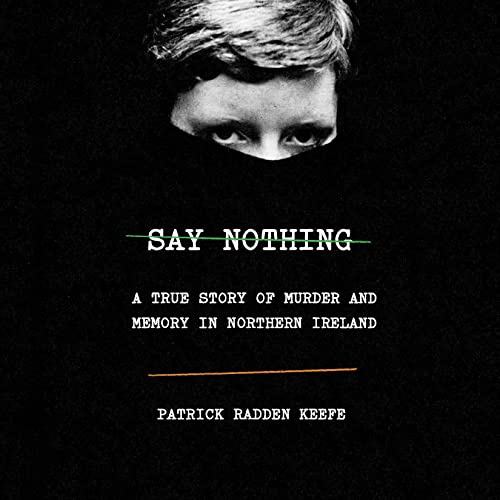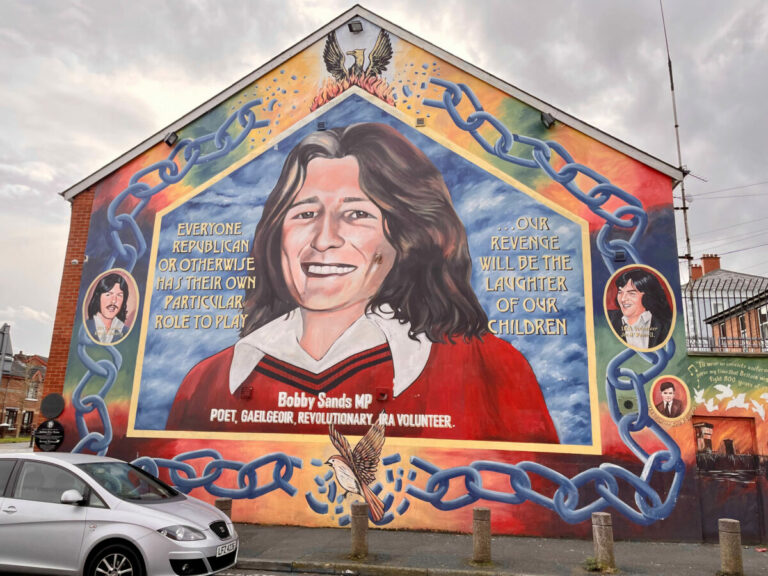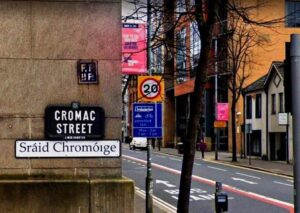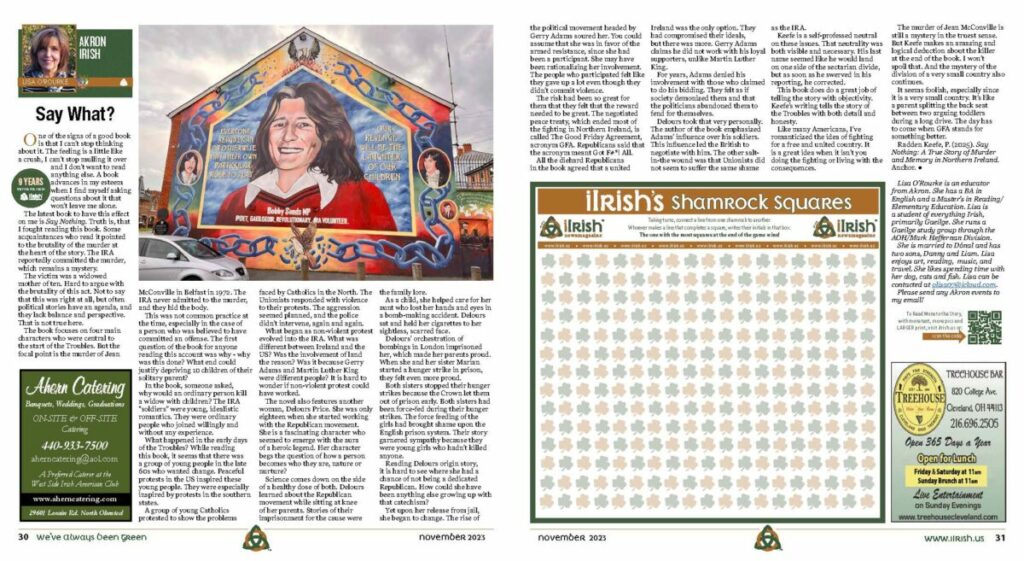
One of the signs of a good book is that I can’t stop thinking about it. The feeling is a little like a crush, I can’t stop mulling it over and I don’t want to read anything else. A book advances in my esteem when I find myself asking questions about it that won’t leave me alone.
The latest book to have this effect on me is Say Nothing, by Patrick Radden Keefe*. Truth is, that I fought reading this book. Some acquaintances who read it pointed to the brutality of the murder at the heart of the story. The IRA reportedly committed the murder, which remains a mystery.
The victim was a widowed mother of ten. Hard to argue with the brutality of this act. Not to say that this was right at all, but often political stories have an agenda, and they lack balance and perspective. That is not true here.
The book focuses on four main characters who were central to the start of the Troubles. But the focal point is the murder of Jean McConville in Belfast in 1972. The IRA never admitted to the murder, and they hid the body.
This was not common practice at the time, especially in the case of a person who was believed to have committed an offense. The first question of the book for anyone reading this account was why – why was this done? What end could justify depriving 10 children of their solitary parent?

In the book, someone asked, why would an ordinary person kill a widow with children? The IRA “soldiers” were young, idealistic romantics. They were ordinary people who joined willingly and without any experience.
What happened in the early days of the Troubles? While reading this book, it seems that there was a group of young people in the late 60s who wanted change. Peaceful protests in the US inspired these young people. They were especially inspired by protests in the southern states.
A group of young Catholics protested to show the problems faced by Catholics in the North. The Unionists responded with violence to their protests. The aggression seemed planned, and the police didn’t intervene, again and again.
What began as non-violent protest evolved into the IRA. What was different between Ireland and the US? Was the involvement of land the reason? Was it because Gerry Adams and Martin Luther King were different people? It is hard to wonder if non-violent protest could have worked.
The novel also features another woman, Delours Price. She was only eighteen when she started working with the Republican movement. She is a fascinating character who seemed to emerge with the aura of a heroic legend. Her character begs the question of how a person becomes who they are, nature or nurture?
Science comes down on the side of a healthy dose of both. Delours learned about the Republican movement while sitting at knee of her parents. Stories of their imprisonment for the cause were the family lore.
As a child, she helped care for her aunt who lost her hands and eyes in a bomb-making accident. Delours sat and held her cigarettes to her sightless, scarred face.
Delours’ orchestration of bombings in London imprisoned her, which made her parents proud. When she and her sister Marian started a hunger strike in prison, they felt even more proud.

Both sisters stopped their hunger strikes because the Crown let them out of prison early. Both sisters had been force-fed during their hunger strikes. The force feeding of the girls had brought shame upon the English prison system. Their story garnered sympathy because they were young girls who hadn’t killed anyone.
Reading Delours origin story, it is hard to see where she had a chance of not being a dedicated Republican. How could she have been anything else growing up with that catechism?
Yet upon her release from jail, she began to change. The rise of the political movement headed by Gerry Adams soured her. You could assume that she was in favor of the armed resistance, since she had been a participant. She may have been rationalizing her involvement. The people who participated felt like they gave up a lot even though they didn’t commit violence.
The risk had been so great for them that they felt that the reward needed to be great. The negotiated peace treaty, which ended most of the fighting in Northern Ireland, is called The Good Friday Agreement, acronym GFA. Republicans said that the acronym meant Got F#*! All.
All the diehard Republicans in the book agreed that a united Ireland was the only option. They had compromised their ideals, but there was more. Gerry Adams claims he did not work with his loyal supporters, unlike Martin Luther King.
For years, Adams denied his involvement with those who claimed to do his bidding. They felt as if society demonized them and that the politicians abandoned them to fend for themselves.
Delours took that very personally. The author of the book emphasized Adams’ influence over his soldiers. This influence led the British to negotiate with him. The other salt-in-the wound was that Unionists did not seem to suffer the same shame as the IRA.
Keefe is a self-professed neutral on these issues. That neutrality was both visible and necessary. His last name seemed like he would land on one side of the sectarian divide, but as soon as he swerved in his reporting, he corrected.
This book does do a great job of telling the story with objectivity. Keefe’s writing tells the story of the Troubles with both detail and honesty.
Like many Americans, I’ve romanticized the idea of fighting for a free and united country. It is a great idea when it isn’t you doing the fighting or living with the consequences.
The murder of Jean McConville is still a mystery in the truest sense. But Keefe makes an amazing and logical deduction about the killer at the end of the book. I won’t spoil that. And the mystery of the division of a very small country also continues.
It seems foolish, especially since it is a very small country. It’s like a parent splitting the back seat between two arguing toddlers during a long drive. The day has to come when GFA stands for something better.
*Radden Keefe, P. (2025). Say Nothing: A True Story of Murder and Memory in Northern Ireland. Anchor.

*Lisa O’Rourke is an educator from Akron. She has a BA in English and a Master’s in Reading/Elementary Education.Lisa is a student of everything Irish, primarily Gaeilge. She runs a Gaeilge study group at the AOH/Mark Heffernan Division.She is married to Dónal and has two sons, Danny and Liam. Lisa enjoys art, reading, music, and travel. She enjoys spending time with her dog, cats and fish. Lisa can be contacted at [email protected].
Please Send Akron area events to my email so we can share them with our readers!






Monthly newsmagazine serving people of Irish descent from Cleveland to Clearwater. We cover the movers, shakers & music makers each and every month.
Since our 2006 inception, iIrish has donated more than $376,000 to local and national charities.
GET UPDATES ON THE SERIOUS & THE SHENANIGANS!